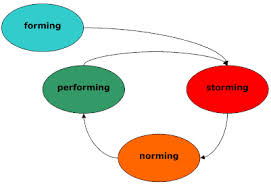Four Phases of Group Development

Groups are a part of most modern work life, as a result, there has been many hours of thought put into how to build teams that are productive and prolific. While most will agree to have an example of where a team went wrong, there are many more groups that will succeed if everyone is invested to a common goal.
Group development is described to have four phases, forming, storming, norming and preforming. Each phase does not have to be met or in that order to make an effective group, however these phases are said to be a good way to improve the effectiveness of a group. To follow is an example group as it goes through the four phases of group development and the changes in task and social dimensions that occur.
The group that I will use for my example is a group formed for a special task at work. The task is a new campaign for a new product in skincare. The group will be 5-6 people that are already employed with the company and will be re-assigned for the project. The company is having financial troubles and most of the group’s livelihood is dependent on the success of the project.
The formation of the group is the first stage to group development and in this group it will not be done organically. While some employees may have voiced their desire to be on the new product group, the group was created by top management based on employee’s skill sets. Each employee of the group has a specific skill set needed for the group, however many have not worked together in the past because they are from different sections of the company. This will take time for the new members to adjust to each other and the new project at hand.
The second phase of the development is storming. In this phase all of the tensions that result in throwing so many different people together occurs. Each group is bound to have primary and secondary tensions that the members in the group will have to work through. Primary tension is the nervousness that is short lived when the group will first meet. Small talk can help to alleviate this particular tension within a group, to help it move on towards the shared goal. Second tensions will occur later when disagreements occur within the group between members. All of this tension is inevitable and will create the tone for the group as it goes forward. With our before-mentioned group, the tension will be lessened because of the shared goal to keep their jobs. However, there will be some secondary tensions created because of the passion to keep a job will be high, as will opinions.
The third phase of group development is norming. In this phase the group will need to decide some implicit and explicit norms of which to go by. In the example group, this will be a time to make boundaries on the way each group member will act and what is expected of each. “Implicit norms are rules that are indirectly indicated by uniformities in the behavior and attitudes of members” (Rothwell, 2013). These implicit norms can be learned by each as they interact and learn about each other. No group will have the same norms, as there will always be new group members involved. This will help the group to work towards their goals without all of the storming from the secondary phase, though it is not clear if that stage will end the first time. The group may have issues and bounce back and forth from the third and second stage as more group members are added, or problems arise with the current members.
The last stage of group development is performing. This is where the group will perform the task(s) that it was made for to begin with. While there is many debates about the effectiveness of groups vs. individuals, many people still believe in the abilities of a group. For our example group, this phase is where they produce the media and advertising, as well as the product that will save the company and thus their jobs in the end. With each task completely, the accomplishment will make the group more cohesive and hopefully work better in the future.
REFERENCES
Rothwell, J. D., (2013), Boston: Wadsworth, Cengage Learning, In Mixed Company: communicating in Small Groups and Teams, Eighth Edition.



